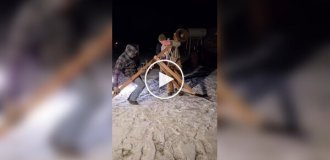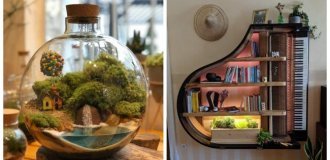Garage cooperatives in Moscow are turning into residential areas (115 photos)
There is a rather interesting trend in Moscow, where ordinary garages in garage cooperatives are turning into real residential areas. Why is this happening? Some people simply do not have the money to buy an apartment in the capital, while others move into their garages to rent out their apartments to newcomers. Today I want to show you the process of building one of these "houses" in a garage cooperative. Let's see what happens next.

Preamble. In the early spring of 2006, I came to work in Moscow. Like other newcomers, I started with rented housing. By 2008, the prices and condition of this housing, as well as the "services" of realtors, had already gotten on my nerves. I started looking for an alternative. I won't bore the reader with a description of all the options and factors I considered and calculated, but by the fall of 2008, the idea had taken its final form: - buy the cheapest garage, in the closest place to work and most comfortable for living, - design and build housing (the project will depend on the specific conditions of the construction site), - costs should be minimal (since it is unreasonable to make large investments in an experimental project) and phased (since it is unreasonable to spend the entire budget at once), - the planned project budget is about 300 thousand rubles. Yes, that's right - approximately the annual cost of renting housing in Moscow.
With the choice of a construction site, everything is simple. I looked through all the ads for the sale of garages, chose the cheapest options, inspected them (immediately with an eye to the possibility of rebuilding into housing), reconnoitred the area and surveyed the natives (for the presence of other interesting options, the nature of the environment, the possibility of connecting to electricity, the prospects for demolition, etc.). As a result, on September 27, 2008, a metal garage was chosen and purchased for only 45,000 rubles, 10 minutes' walk from the metro, in a prestigious area of the capital, 9 km from work and only 10 km from the Kremlin. One of the locals was hanging around the gate waiting for a "showdown".

The construction was carried out on weekends, by our own efforts (1 person). An excellent warm-up after a week of office work at the computer! So the advantages of the project include saving on visiting the gym. In the active phase of construction, the phrase was relevant for me: "O-o-o, finally Monday!!!" We dismantle (and in some places - just break) the old garage. We carefully store the released metal nearby - we will need it later.
Rear view

Clearing the construction site for a new building...

..and level the ground.

Bringing in a KAMAZ sand...

...and level the sand cushion to the design mark.

Oh, I'm already describing the construction progress, but I forgot to introduce the inquisitive reader to the project. So what am I building here? I'm building nothing less than a two-story modular cottage with fully autonomous life support systems. Two-story - that's clear. Modular - consisting of modules that can be quickly and easily relocated. At that time, I didn't know all the risks of the project, so I preferred to have a backup option in case of, say, the demolition of the garages, problems with the environment, etc. If problems arose, I would load the modules with a crane into two trucks and move to another site. Fully autonomous life support systems mean complete freedom from all centralized communications and "bindings" to a specific location, using only your own and imported resources and, therefore, not obligated to anyone. My project was flawless, including legally: the site was allocated to me as a member of the garage cooperative (which is confirmed by documents), I will install on it, without a foundation, on the ground, two modules, which are essentially steel cubes (this is a permitted use of the site). I have documents for the cubes and their contents. No laws concerning real estate or housing can apply to these cubes (since they are simply neither one nor the other). Thus, to the question about the legality of living in the garage, I answer - no laws are violated, no one lives in the garage, and no one has the right in any way to limit the owner of the iron cube, his right to be inside this cube or to store various objects and liquids in it. With the exception of those directly prohibited by law - such as weapons, drugs, explosives, etc. That is, the complete autonomy of life support systems is also a factor in the legality of placing such a structure on a site equipped with neither water supply nor sewerage. However, for 5 years, no one has ever made any claims against me, asked any questions, or checked the legality of my residence. But nevertheless, I was ready for any surprises. Probably, the reader has already guessed that with such a serious approach to the matter and careful consideration of all the details, the project was doomed to success? Yes, that's right. But a little later.
In the meantime, the future successful Muscovite poses after a hard day of work throwing sand with a shovel and leveling it, against the background of the future lair of luxury and comfort. He asked a passing pedestrian to take a photo. He hid his face - why do I need extra popularity?

We lay sheets of metal from the roof of the dismantled garage on the leveled sand. The result is a perfectly horizontal platform with a hard (steel!) covering. The first module can be installed. Surprise! In addition to a detailed PHOTO report, I also have a detailed financial report and timing. How could it be otherwise? An investment project is not a piece of cake! An accurate assessment of its economic indicators is necessary. Thus, reader, very soon you will receive an accurate and comprehensive answer to the question "How to build a house in Moscow for 300 thousand rubles?", which has been troubling "Muscovites spoiled by the housing issue" at least since the creative heyday of the author of the quoted phrase. Here is the timeline and costs at the time the site was ready (apologies for the formatting damage when transferring data from Excel): 09/27/2008 Purchase of garage 45,000 Entry fee to GSK, payment for 2008 2,000 10/04/2008 Flashlight, batteries 97 10/04/2008 Axe 156 10/05/2008 Bayonet shovel 160 10/11/2008 Crowbar, shovel scoop, boots, gloves, plumb line, bucket. 900 10/23/2008 Galvanized profiles 3 m. 3 pcs. 420 Spirit level 1.5 m. 550 Metal shears 300 Plumb line 200 10/25/2008 Padlock 78 Quarry sand 8 m3 6,000 Total, as of October 25, 2008, 55,861 rubles were invested.

We have delivered and are installing the first module.

And here it is - a standard 20-foot container, 6x2.5x2.5 meters, hermetically sealed, with a hermetically sealed door, capable of withstanding a multi-ton load from above and a multi-point storm.

Beauty. We clean inside, lay cardboard on the floor...

...now there is a place to put tools, building materials, special clothing! There is a place to change clothes, take shelter from the rain or rest. My own premises in Moscow! Hooray! Hooray! Hooray! Let's count, dear moles © 10/26/2008 20-foot container. 38,000 Loading and unloading, transportation of container 9,600 Transportation of container by GSK 100 11/01/2008 10-liter water canister. 3 pieces 270 Water canister 20 liters 159 Mop 61 Terry towel 2 pieces 34 Latex gloves 2 pairs 32 Rubber gloves 32 Respirator U-2K 22 Garbage bags 60 Broom 49 Folding chair 300 11/02/2008 Marble delivery 50 Payment for garbage removal 200 11/03/2008 Galvanizing 2 m2 thickness. 0.45 mm. 400 Bolts 15 pcs. 100 Wood saw 200 Total cost for 1 module - 49,669 rubles.

We are covering the gaps between the neighboring and my garage with galvanized steel, laying out the area in front of the gate with marble (found at the dump, of which there is plenty near the territory). In place of the future main entrance - for now - a steel panel from the old garage, supported by a rusty barrel.

We are assembling the back wall using parts from the old garage. By the way, the exit to the back yard is ready - the wicket gate from the old garage is quite functional. And the former gate itself is now just part of the wall.

View from above on the fenced area. Now my construction site is 7 x 3.5 meters.

We are transporting the second module.

Installed. With a console projection from the facade - both an increase in area and a canopy over the gate.




So, the second module is the BK-00 factory block container assembly, external dimensions: width 2.45 m, length 5.85 m, height 2.45, supporting frame - welded metal, frame - wooden, roof - flat welded from 0.8 mm sheet, external cladding - galvanized corrugated sheet C10-40-1150, internal finishing - plastic panels, plank floor, window with grille, door. We install it on spacers sawn from a board, foam the joints of the modules.

Costs: 11/15/2008 for 2 modules - 80,014 rubles. The total construction budget by 07.12.2008 was 186 thousand rubles. Normal, looks like we'll fit into the planned budget! By the way, as a piece of advice: Never buy READY-MADE block containers. The quality of their manufacture and especially the insulation is a complete mess! I had to remove the sheathing and practically lay the heat and wind insulation anew. I added a 5 cm layer of ISOVER 11 to the crookedly laid IN PLACES 5 cm foam plastic. As a result, the total thickness of the insulation became 100 mm and all the cracks were eliminated. We got an "arctic" modification of the block container! In general, it was necessary to buy only the frame with the external sheathing, insulate it myself, lay the floor and sheathe the walls and ceiling with DRYWALL and cover them with wallpaper. In the end, the price would have been almost the same, and in terms of quality - incomparably better. So, the core of the structure is ready, the fate of the project now depends only on the creation of reliable and autonomous life support systems. The issue with the heating system was resolved unexpectedly simply - it turns out that European bourgeois have long been producing, and on an industrial scale, an ideal solution to the problem of autonomous heating of small buildings - a gas convector. If you are interested in technical details - google it yourself, but I will say honestly - they shocked me!
This convector + propane cylinder = reliable, stable, comfortable heat in any barn, for mere pennies. Piezo ignition, thermostat, burner failure protection. Air intake and exhaust of combustion products - from the outside, through a coaxial pipe, which is also a heat exchanger, heating the incoming air with the heat of the exhaust gases (+ 10% to efficiency). The combustion chamber is completely isolated from the room, so even in the worst (almost improbable) case, the gas will not penetrate the room, but will go out through the pipe and dissipate. I applaud the bourgeois engineers and manufacturers, and buy this miracle of engineering for 10,000 rubles. Isn't it wonderful?

We install it strictly following the instructions and showing our own ingenuity and resourcefulness. By the way, as it turned out, it was unnecessary to cover the wall (even a plastic one!) with galvanized steel. This device does not heat the wall it is hanging on at all. I put a sheet of galvanized steel under it, having misunderstood the word "CONVECTOR" in its name. Note: Wikipedia kindly informs us that "A CONVECTOR is a heating device in which heat from a coolant or heating element is transferred to the heated room by CONVECTION. Natural convection, in which warm air, already heated by contact with the coolant or heating element, rises upward, and its place is taken by colder air in the room, is enhanced by the design of the convector." I stand up and applaud the bourgeois engineers once again!

And finally, the long-awaited moment! Turn the handle, click the piezo ignition button - through the viewing window we watch as a blue light flashes above the burner.

Here the heat exchanger (black case with a viewing window) began to heat up. Here it is already scorching hot. I install the beautiful white case in place - a stream of warm air begins to flow through its holes. About half an hour later, it becomes hot in the sweatshirt and I undress. In another half an hour the room temperature reaches room temperature.

Wind protection grille on the end of the convector's coaxial pipe (Coaxial means the exhaust pipe is located in the center of the air intake pipe).

It's minus 10 outside. The heating system is completely ready and has been tested. I won't have to change into drier, frozen work clothes in the cold anymore. December 27, 2008. New Year is coming soon. I'm leaving for my homeland for the Christmas holidays, and will continue my Moscow construction after my return. Happy New Year to all! Good luck to us in 2009!


January 2009. Laying linoleum. I'm installing (laying out) furniture


I'm pumping up the furniture. I'm making the bed. Judging by the size of the bed, I'm an optimist and I'm sure that Muscovites will appreciate the coziness of my home and my own merits and will be frequent guests (at least) or roommates (ideally) here. As they say: "You can judge a man's self-esteem by the number of condoms he takes on a date. Even if it's his first date."

The heating works, there is a bed. I spend a test night. Alone. In a steel box, in the middle of a strange, deserted area filled with various garages. Normal. The house warms up well during the night, in the morning it is warm and cozy. I have cookies for breakfast, washing it down with water from a bottle. I want hot tea - I need to urgently get a kitchen stove. But this is not a problem. The most critical issue for the project is on the agenda - autonomous water supply and sewerage, a working shower and sink. If this issue cannot be resolved, this is not a residential cottage, but just a heated barn. I solve the sink issue simply - I use a time-tested, "village" system. It should be noted that I was born and raised in the village, so I do not experience culture shock when I see a washbasin. The advantages of a washbasin are its simplicity and super-economical use of water. After all, for the first 17 years of my life I only used a washstand, millions of Russian villagers and summer residents still use them, and no one complains. The shower is a more complicated issue. I am an office worker - a daily shower, shave and a clean shirt are a must for me. I know that a person with a short haircut needs 10 liters of warm water to wash. In order to wash well with such a quantity of water, it is necessary for its thin stream to flow from above and be able to quickly regulate and shut off. A compact shower stall with a warm water reservoir on top and a tap is taking shape. A storage electric water heater under the ceiling? Not an option - you can't count on an uninterrupted power supply, a low ceiling and a high shower tray do not leave space for a water heater, in addition, it is necessary to ensure the ability to easily drain the water from the system. In order to be able to completely turn off the heating in the winter, during periods of my long absence. I choose a simpler, more reliable and energy-independent option: water is heated to the desired temperature in a 15-liter enamel tank on a gas stove (readiness time is 15-20 minutes), then pumped into a compact supply tank above the shower stall, from where it is consumed by gravity as needed. When it runs out, an additional portion is pumped from the tank. So, per week, one person will need 60-70 liters of tap water and about 10 liters of drinking water (I have breakfast and lunch at work, in the evenings only tea. Well, and soup on weekends). Thus, to ensure water supply, once a week I have to buy 2 five-liter bottles of drinking water in Auchan (for 100 rubles) and fill 2 twenty-liter canisters and 3 ten-liter canisters with tap water for free. It's a piece of cake - I load the canisters into a cart at the nearest shopping center, fill them with water from any tap I find, and roll the cart to the car. I transfer the canisters into the trunk, then carry the canisters 15 meters from the trunk to the house. A little physical activity is very useful for office plankton! And you can also fill up with water at work, or at friends', or anywhere. One "BUT", the car becomes part of the water supply system (and gas supply - too), its loss for a long time is very critical - I will have to bring gas and water by taxi.
I buy a shower cabin and start assembling it. The tray and walls are assembled.

Other components (sink, washstand, gas stove)

We mold "from what was" a supply tank with a tap. We connect the components with hoses.

The "heart" of the system is a country shower-stomp. Its energy independence and the highest technical and economic characteristics make it the undisputed leader among all other possible pump options. Pumping 10 liters of water is just 20 times (without being distracted from washing) massaging elastic red "tits" with your heels (which for a man, you must admit, is not at all difficult, but rather - pleasant:)


Washstand, sink, gas stove are ready. The hose hanging behind the washstand is connected to the pump. You need to lower its end into a tank of warm water standing on the tile. And you can go to the shower.


You may ask: "What about laundry?" I answer: "While there are self-service laundries in Moscow, it is easier to go and wash in rented washing machines than to build an autonomous one and bring water for it." 1 wash in a machine for 8 kg of laundry costs 200 rubles. I simply bought 30 shirts and 30 pairs of socks and did the laundry only once a month. I loaded 3 machines at the same time. In total, the cost of washing was about 600 rubles per month. I watched TV for a while, waiting for the wash to finish. I put the damp washed laundry in bags and took it home. I hung it up, opened the ventilation completely and increased the temperature with the heater thermostat. After a few hours, the laundry dried. Imagine the amount of moisture evaporated from SUCH a volume of laundry and estimate the power reserve of the heater and ventilation system of the house. In the photo - about a fifth of the usual volume of washing is dried.

Sewerage. Initially - into canisters. From the washbasin: in winter - into a 10-liter canister standing under the sink,

...in summer - into a 30-liter shower canister standing outside.

Why not there in winter? The shower has a one-time powerful discharge of warm water and the pipe will not freeze - all the water flows out of it before the heated pipe freezes. The washbasin drains sluggishly - the pipes will not warm up and the water in them will gradually freeze. As I wrote above, the drain of the sewage into canisters allows me to declare the autonomy of the building and the absence of its impact on the surrounding area. In the event of attempts to make claims against me, I could demonstrate the twisting of the sewage canisters with plugs, loading them into a car and removing them for disposal in an unknown direction. However, since no claims were made, and soapy water is not classified as highly toxic waste, there were no problems with its disposal in the polluted territory of the garage cooperative. About a couple of times a week (and only in winter) it is necessary to empty the washbasin canister. Once every 2 days (in summer) - the shower canister. In winter, instead of a canister, put a plastic bucket and kick it on the bottom, in the nearest snowdrift, every day a piece of ice in the shape of this bucket is deposited. In the spring it will melt. For those who like to squeal about "They've polluted Moscow", I recommend walking around the garages and admiring the puddles of machine oil, dumps of canisters from under it, used filters, bottles, bags, corpses of homeless dogs (and their future followers, who are also not busy cleaning the territory), etc. This is a real problem. And considering that garbage containers are placed everywhere, its cause is the banal laziness and indifference of the natives. I repeat once again, the design of my building provides for the removal and disposal of waste. Of course, ha-ha, I removed liquid waste and handed it over for disposal to a specialized company. If necessary, I will even present supporting documents. Law and order - above all! So, the main life support systems are ready (in addition to those described, there is also a ventilation system and later there will be an air conditioner). I will not describe the toilet, since I do not see any problems with its design. There are dozens of ready-made solutions - from an elementary plastic bottle and bucket to bio-toilets of various designs, shapes and volumes. After all, if you, the reader, cannot independently solve the problem of disposing of several hundred grams of your own excrement, then what, baby, are you doing on this site? And where is your mother looking?
Since the end of March 2009, I began permanent residence in my new home, simultaneously finishing it. Everything is the same - exclusively on weekends. Interior in 2009


I hung a thermometer with a remote sensor on the wall. Above - the temperature inside, below - outside.

In June 2009 I connected to electricity, got used to it, got used to it...

.. and construction intensified.

From the remains of the old garage I built up the rear facade.

I bought an inverter welding machine and an angle grinder. And the work began to boil.

The extension is attached to the modules with screws - to preserve the ability to quickly disassemble and transport the building.

I decided to practice making steel doors from the emergency exit on the 2nd floor (to the neighbor's roof). Considering that I just learned welding on the Internet, it's not bad for my first door. Only after welding a kilogram of electrodes did I begin to feel the essence of arc welding - to understand the dependence of the set current on the thickness of the metal being welded, the position of the seam, etc. It seems that experience is important in welding - the longer and more you weld, the better the seam.

General view of the emergency exit door.

Summer landscape from the backyard - isn't it a village idyll?

Having trained in welding, we move on to the main facade.

The main entrance door from the inside...

...and outside

I'm starting to paint the facade. To work on the upper part of the facade, I built scaffolding from the last remnants of the old garage (pediments). With a fenced work platform! Working from a ladder is too dangerous, and becoming disabled was not in my plans. Failure to comply with safety precautions is the cause of injuries! And given the specifics of construction work, injuries could be severe, even fatal. A fall from the stairs could easily have ended both this project and my ability to actively live.

The painted main facade.

I built a fence from the remains of the material so that passing cars would not splash mud from a puddle onto the freshly painted facade and the gate.

I'm working on the eastern wall

The roof is ready

And the hermetic joint of the western wall with the neighbor's roof is also ready.

SUDDENLY! A film crew arrived, set up props, cameras, actors, and began filming some series about cops and bandits! Apparently, the brutality of our landscape did not leave the filmmakers indifferent! Thus, the freshly painted facade of my house made its modest contribution to Russian cinema. Alas, this bright film debut went unnoticed by the general public. In vain I paused my work so as not to disturb the filmmakers with the noise of the "grinder".

A couple of hours later, the filmmakers moved to film shootouts on the roofs of neighboring garages, and I continued working on the eastern facade. Welded a window with a powerful grille and a door for another emergency exit.

Done.


Inside, I made an interfloor ceiling from plywood on steel beams from corner


I'll soon replace this temporary staircase with a new one.

Another window with a grate (on the north facade)

The same from the outside

I'm welding a new staircase. Steel...

.. with wooden...

...steps.

Let's take a look at what's in the first module. Warehouse. Just a warehouse for tools, building materials, household utensils. Illuminated by a floodlight.

It's November already. It's time to end the 2009 construction season. It's cold and rainy. The welding mask window fogs up from breathing. The building's perimeter is closed. Ready for winter.

Almost everything is built inside, too. The finishing remains.


Let's sum up the outgoing 2009. This year was the most important one in the fate of the little house. During this year, the little house turned from a vague project into my cozy and beloved home. I didn't have to push my way through the metro - the road to work took me about 15-20 minutes of a quiet car ride, through the most beautiful places in Moscow, on roads not prone to "traffic jams". My parking space (and even several), right under the window, was always free. I didn't have noisy neighbors, guitarists and alcoholics didn't gather under the window. In a word, I lived in an idyll, not feeling the problems that bother Muscovites. My neighbors (who only appeared during the day) were garage owners and employees of various auto repair shops, which were abundantly located on the territory. Excellent men, often surpassing me in straight-armedness, experience and passion. The only difference is that their passion concerned various types of transport, and mine - building a house. I am also interested in cars, but my Toyota, being very reliable, did not often spoil me with the opportunity to demonstrate my abilities in its repair. Nevertheless, it was great to have friends who are auto specialists with all sorts of tools, knowledge and experience as neighbors. To watch the process of their work, the progress of their auto projects, to examine and discuss their mega-creations. My neighbors have repeatedly helped me out with advice, tools, parts, and even once - first aid (I injured my hand while working carelessly with an angle grinder). Thank you, neighbors! Let's calculate the expenses for 2009 - 297,319 rubles. The budget is almost exhausted, but the building is almost ready. Besides, it has been in use for a long time and already saves me a lot of money. Next year, we need to revise the budget upwards - the house is about to become self-sufficient. Happy New Year 2010 to everyone! Good luck to us in the coming (abnormally hot) year.
Winter 2010. The dream of living in a house with a beloved woman has not yet come true :( You have to live not with a woman, but with three gas cylinders. One feeds the heater, another one is in reserve. The third (small) is for the stove.

In the frosty periods of January-February, one cylinder lasts for 8-9 days. When one runs out, I connect another, and the next weekend I take the empty cylinder to the gas station. I store the filled cylinder outside, bring it inside shortly before replacing it. The cylinders are certified and tested. The safety instructions for using gas appliances have been reread several times once. But it has to be broken for more complete gas production from the cylinders. Emergency exits are cleared of snow. Choking, exploding or burning is not in my plans. We'll break through. To heat the house, during the year it is necessary to burn 17 cylinders of propane. Most of them fall on frosty January-February.
February 2010. A fierce snowstorm. I watch from the window at the skidding cars. Then I took a shovel and went to dig out the poor guys. For them - freedom from snow captivity, for me - useful physical exercise in the fresh air. And why are they stuck there? Why do they accelerate so much? I drive my car (it is in the foreground of the photo) there in any snowfall. Tight.

I built a new shelf for the TV - you can install shelves at any height and add more (if necessary)

I made a sealed ceiling in the shower stall and replaced the storage tank with a more advanced model. The shower cabin should be as airtight as possible - less steam emissions and warmer.

Spring 2010 has arrived - I finished painting the facade.

We paint in the same color scheme and in the favorite "industrial" design.

Exterior finishing of the building finished.

I'm starting the interior decoration.

The color I like and it's good inside looks good.


We use red signal color to mark dangerous, steep steps. I didn't install railings - they would have interfered with carrying gas cylinders, for which I paid a price a year later, in the spring of 2011 - I tripped and slid down the stairs on my tailbone. It was very, very painful. Learned a memorable lesson about the need to strictly adhere to building codes and regulations.

The sewer pipes are insulated.

Linole is laid in the 2nd floor corridor



Installed the air conditioner.

View of the air conditioner from the inside. I bought it for next to nothing, back in May, before the abnormal heat and fires of 2010. So I didn't suffer much in the heat - I slept wrapped in a cotton blanket, blown by a fresh, cool breeze. Was it really that hard in Moscow in the summer of 2010?

We decorate the entrance with paving slabs (adhering to the chosen color scheme) and a wooden platform.

We lay the floor of the first floor with the same tiles.

Actually, that's it. This completes the construction, the facility is ready. July 10, 2010. Costs as of this date are 328,669 rubles. We can consider them the final construction budget. Although, if you look at the costs more closely, the costs already include a lot of operating and household expenses. So I suggest we consider that I have kept within the promised 300 thousand. And considering that I have been living in the house for over a year, the amount of savings on rent has already exceeded the construction costs. That is, the project has ALREADY fully paid for itself and I have "come out on top"! In one year! How do you like these investment indicators?
October 2010. It's time to take care of comfort. And I am tired of constantly inflating this inflatable mattress. Bought a brand new, orthopedic one.


January 2011. For lack of other physical work, I entertain myself by clearing snow from my and neighboring roofs. And also some kind of ice sculpture - in the photo a snow sofa for... yeah, who knows...

March 2011. Sometimes I dabble in welding.

Here, for example, I welded a bracket.

September 2011. Painted the window and the grille. Renewed the paintwork of the fence. Covered the roof with a fresh layer of mastic. That's it. No other work required. Boredom.

November 2011. Problem. The power supply stopped. In principle, the project initially included low dependence on external communications. After thinking, calculating, bought a gasoline-electric generator. 1 kW, digital, in a noise-proof casing.

I put it on the neighboring roof. It's rattling quietly outside...

...and it's light in the house and the electrical appliances are working.

Winter 2012. Apparently, I'm really yearning for a woman's love and have an excess of unspent energy - how else to explain the creation of this snow sculpture in front of the house? Look how the sculpture's chest, waist, hips, and lips are accentuated! Old man Freud could probably tell a lot about me looking at this creation ))

The generator has been moved inside, its summer terrace (and the door to it) are covered with heavy snow. I dispose of exhaust gases outside through a pipe.

And inside it is warm, light, clean and cozy.

In April 2012 I decided to radically upgrade my energy system. An electric power converter and a special 100 A-h battery allow me to start the generator once a week to charge the battery. Then no hassle - the power supply is enough for a week of powering a laptop and lighting.

Russian development. I applaud the Russian engineers and manufacturers of this device! Technical details - google it yourself.

The immediate plans included purchasing solar panels and a controller for them (also Russian, by the way). This would have turned my house into a truly autonomous one. And solar panels on the roof would have added +100500 to its brutality and pathos. But the plans were not destined to come true - in June 2012, a new supplier of grid electricity appeared on the territory, I connected to it and curtailed the program for developing my own, alternative, solar energy. Therefore, alas, dear reader, you will not learn about the successful implementation of this undoubtedly interesting program. Although no obstacles to its completion were foreseen - the components are being manufactured. And although the price of these components is quite decent, for a project whose budget surplus by 2012 exceeded a million rubles, this did not seem difficult. In the photo - also a modular, autonomous, residential building with solar panels. 80 lvl

This is where my story comes to a happy end. Over the 5 years of living in this house, I saved about one and a half million rubles on rent, thereby significantly accelerating the process of accumulating funds needed to buy a Moscow apartment. Having added money from the sale of my apartment in N-sk outside the Moscow Ring Road to my savings, I bought an excellent apartment in a wonderful place in Moscow, a 7-minute walk from the metro. Therefore, in July 2013, I moved from the house to my new apartment. In a year, I plan to finish the renovation, and given the planned renovation budget (many times exceeding the budget of the above-described experiment) and my passion for this business, the result promises to be amazing! But that's a completely different story...
I'll finish my story with photos of the empty house. It should go to the new owner in this state. At the moment (October 2013) the house is on sale for 400 thousand rubles - i.e. almost at the cost of its construction.
























